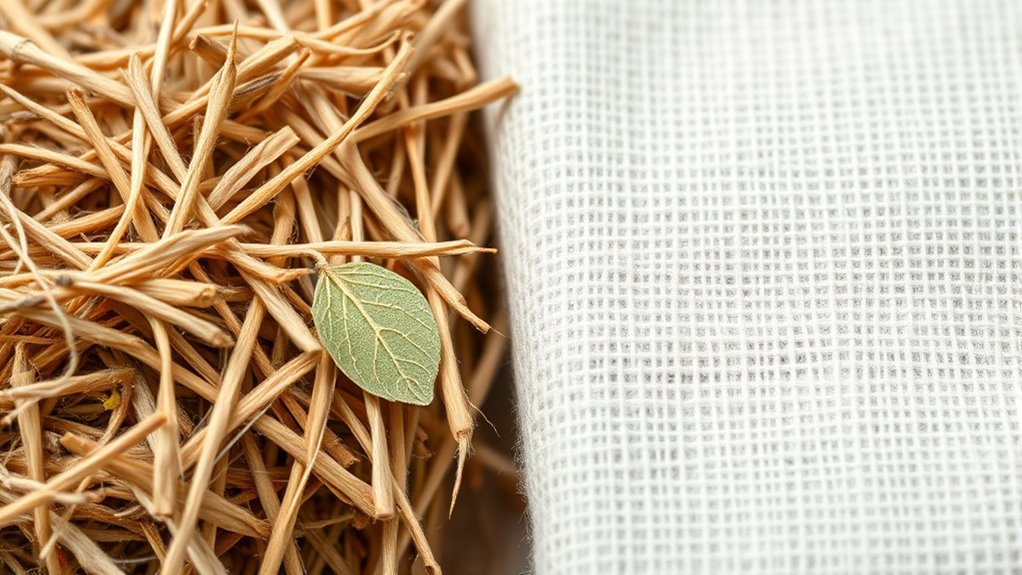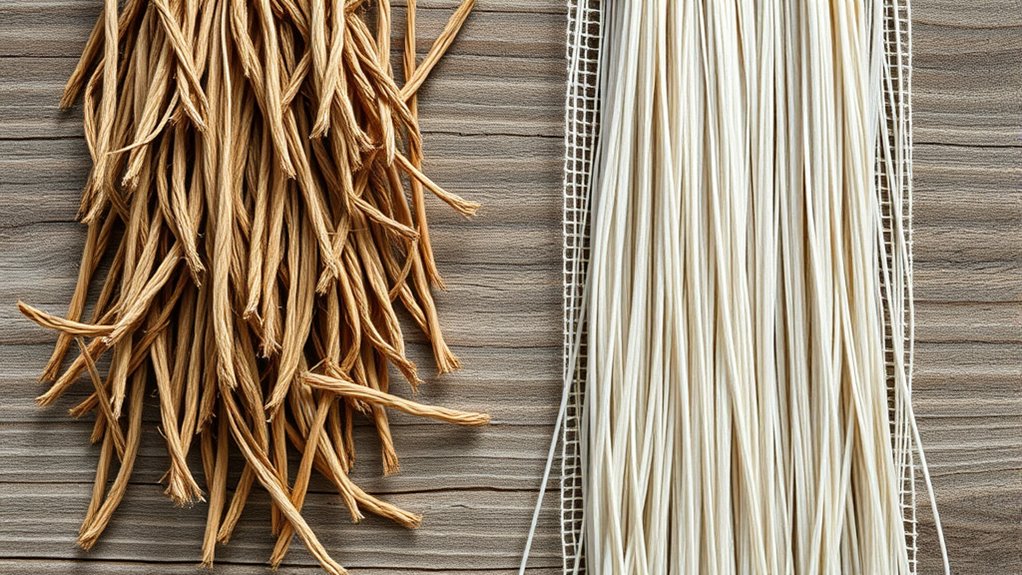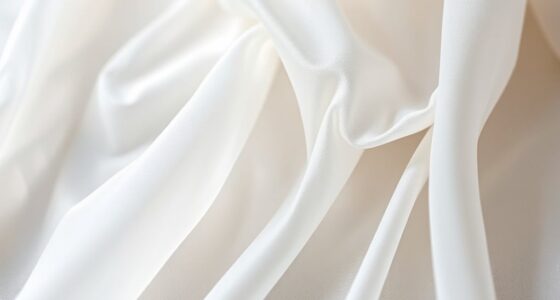Hemp and linen both come from natural plant fibers, but they differ in sustainability, durability, and feel. Hemp is highly eco-friendly, requiring minimal water and no pesticides, and its fibers are very strong, making garments long-lasting. Linen offers a smoother texture and a refined look but may need more maintenance. Linen might wrinkle more, while hemp softens over time without losing toughness. Exploring these differences can help you choose the best for your needs.
Key Takeaways
- Hemp is more sustainable, requiring less water and chemicals, and has a faster growth cycle than linen.
- Hemp fibers are stronger and more durable, making garments last longer with increased wear and washing.
- Linen offers a smoother, refined texture suitable for polished, elegant clothing, whereas hemp starts rougher and softens over time.
- Hemp is ideal for casual or utility items due to its toughness, while linen’s refined feel suits formal or sophisticated wear.
- Both are eco-friendly, but hemp’s minimal resource needs and rapid growth give it an edge in sustainability.

When choosing between hemp and linen, understanding their differences can help you make an informed decision. Both are natural plant fibers celebrated for their eco-friendly qualities, but they each have unique characteristics that can influence your choice. One of the key factors to contemplate is their sustainability benefits. Hemp is often regarded as one of the most sustainable crops available. It grows rapidly, requires minimal water, and thrives without the need for pesticides or herbicides. This means cultivating hemp has a lower environmental impact compared to many other fibers, including linen. Linen, made from flax plants, is also eco-friendly, but the cultivation process generally consumes more water and may involve the use of chemicals to produce high-quality fibers. If sustainability is a priority for you, hemp’s minimal resource needs make it an attractive option.
Fabric durability is another important aspect to deliberate. Hemp fibers are incredibly strong, making garments and textiles crafted from hemp exceptionally durable. They tend to become softer with each wash without losing their toughness, which means your hemp items can last for years with proper care. Linen also boasts excellent durability, with fibers that resist wear and tear over time. However, linen tends to be a bit more prone to wrinkling and may require more maintenance to keep looking crisp. When it comes to longevity, hemp’s inherent strength gives it an edge, especially if you’re seeking long-lasting, hard-wearing textiles.
You should also think about texture and feel. Hemp fabrics tend to be slightly rougher initially but soften considerably with use and washing. Linen, on the other hand, has a smoother, more refined texture right from the start. Both fabrics are breathable and moisture-wicking, making them great choices for clothing, bedding, or upholstery, especially if you want something natural and comfortable. However, hemp’s rougher texture might be more suitable for utility items or casual wear, while linen’s smoothness lends itself well to more refined garments. Additionally, the popularity of ice cream flavors and varieties shows how consumer preferences can evolve, highlighting the importance of choosing products that align with your values and needs.
Frequently Asked Questions
How Do Hemp and Linen Affect Allergy Sufferers Differently?
You’ll find that hemp generally causes fewer allergenic responses than linen, making it a better choice if you’re sensitive. Hemp’s low irritant potential means it’s less likely to cause skin reactions or respiratory issues. Linen, on the other hand, can sometimes trigger irritant responses, especially in sensitive individuals. So, if you’re prone to allergies, hemp might be the safer, more comfortable option for you.
Are Hemp and Linen Environmentally Sustainable Throughout Their Lifecycle?
Think of hemp and linen as eco-friendly marathon runners—sustainable throughout their lifecycle. Hemp’s rapid growth and minimal water needs reduce environmental impact, making it highly sustainable. Linen, derived from flax, also boasts a low environmental footprint, especially when grown organically. Both fibers support lifecycle sustainability by requiring fewer chemicals and resources. By choosing hemp or linen, you support eco-conscious practices that help lessen pollution and conserve resources over time.
What Are the Care and Maintenance Differences Between Hemp and Linen?
You should know that cleaning methods and storage requirements differ for hemp and linen. For hemp, wash in cold water and air dry to prevent damage, and store in a cool, dry place to avoid mold. Linen needs gentle washing, preferably in lukewarm water, and should be ironed while damp for best results. Store linen flat or hanging in a breathable environment to maintain its quality over time.
How Do Hemp and Linen Compare in Terms of Durability Over Time?
You’ll find that hemp generally offers greater fiber strength and aging resistance than linen, making it more durable over time. Hemp fibers tend to resist wear and tear better, maintaining their integrity as they age. Linen, while strong initially, can weaken with prolonged use and exposure to environmental factors. So, if long-term durability is your priority, hemp is the better choice for lasting quality.
Can Hemp and Linen Be Blended With Other Fibers for Enhanced Properties?
You can definitely blend hemp and linen with other fibers for textile enhancement. Fiber blending allows you to combine their natural strengths, like durability and breathability, with other materials such as cotton or silk. This process creates fabrics with improved softness, flexibility, and performance. By experimenting with different fiber mixes, you can tailor textiles to suit specific needs, making your garments or products more versatile and long-lasting.
Conclusion
So, whether you choose hemp or linen, you’re weaving your own story with nature’s fibers. Hemp’s strength is like an unbreakable thread, while linen’s softness offers gentle comfort. Think of each fiber as a chapter—one sturdy and resilient, the other delicate yet enduring. Ultimately, both plants help you connect with the earth’s wisdom, reminding you that your choices can grow into a tapestry of sustainability. Your decision shapes a future rooted in nature’s timeless craft.








